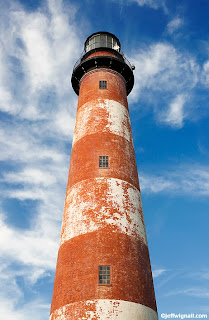 If someone told you that they could sell you a single lens filter that could darken blue skies, saturate colors, remove surface reflections (including window reflections), intensify rainbows and reduce haze--would you buy it? You bet you would. And a polarizing filter can do all of those things and, at times, they seem like an almost magical accessory.
If someone told you that they could sell you a single lens filter that could darken blue skies, saturate colors, remove surface reflections (including window reflections), intensify rainbows and reduce haze--would you buy it? You bet you would. And a polarizing filter can do all of those things and, at times, they seem like an almost magical accessory.Polarizing filters are one of the most versatile and important photo accessories that you can own and, even though I use one less with digital cameras than I did with film cameras (I'll explain why in a minute), I still use one regularly. Polarizing filters work (there's a lot of physics going on here and you can find lots of info online if you're curious) by blocking certain wavelengths of light from entering the lens and allowing others. They are sold in a rotating mount that screws to the front of your DSLR lenses and as you rotate the filter, it blocks different wavelengths. Among the things that a polarizing filter does superbly well:
- Darken blue skies. Be blocking extraneous scattered light reflections in the atmosphere, you can rotate the filter to darken blue skies. I use them less for this than I used to because I can create the same sky-darkening in editing and have somewhat more control. I also feel that polarizing filters tend to over-darken skies with digital cameras if you're not careful about exposure and the exact rotation position. Sky darkening works best when the sun is to your right or your left (of shooting position) and not at all when the sun is behind or in front of you. You can see the effect in the viewfinder as you turn the filter and as you alter your position to the light.
- Saturate colors. Again, because you're blocking superfluous surface reflections, when you turn a filter the colors of things like leaves and grass or people's clothing becomes more (or less) saturated. This is the main thing that I used to use polarizing filters for, but again, I can saturate colors more selectively in editing. Still, I will sometimes use a polarizing filter with landscapes where I want to control the color saturation at the time I'm shooting.
- Eliminate reflections. This is something you can't do very easily in editing! You can remove reflections from any nonmetallic surfaces just by rotating the filter. If you're shooting a store-window display, for example, you can penetrate the reflections to reveal what's behind the glass. This can be a real life saver in a lot of situations, especially when you're traveling and might shoot a lot of store windows or displays.
- Reduce atmospheric haze. Polarizing filters are much more efficient at reducing haze (not fog) than so-called "UV" (ultra-violet) filters and they're essential in landscape photography for that reason.
- Intensify rainbows. No joke! By reducing the atmospheric haze and by blocking certain wavelengths of light you can strengthen the colors of a rainbow substantially. And because you can see the effect in the viewfinder, you can decide how much intensity you want (yeah, like anyone would dial up less than maximum color with a rainbow).






1 comment:
Déja vu! This was also taken with a polarizing filter:
http://www.flickr.com/photos/r_topor/3732086232/
Post a Comment